
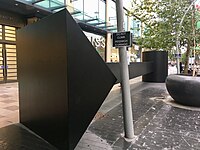
Garth Evans (born 1934) is a British sculptor and former college lecturer at St Martin's School of Art, London. [1]


Garth Evans (born 1934) is a British sculptor and former college lecturer at St Martin's School of Art, London. [1]
Evans' mother was from Pencoed, her father and brothers were South Wales coalminers. [2] He was born in Cheshire in 1934 and studied at the Slade School of Art in London. [3]
Evans exhibited widely in the 1960s and 1970s including in the group exhibitions British Sculpture '72 at the Royal Academy of Arts (1972) and The Condition of Sculpture at the Hayward Gallery (1975). He had a survey exhibition of his work at the Yorkshire Sculpture Park in 2013. [3]
Evans describes his sculptures as figurative. [4] His works were known for their size and grand statements, though they became smaller and less dramatic from the late-1970s onwards. [4]
He has been recipient of a number of awards including the Guggenheim Fellowship and the Pollock-Krasner Foundation Award. [3]
Evans created some site-specific sculptures in South Wales in the early 1970s. These included a 40-foot-long unnamed sculpture in coal-black steel, which was installed on The Hayes, Cardiff, in early May 1972. [5] It was inspired by Evans' family stories about the South Wales coalmining (and steel) industry. [2] The sculpture was commissioned by the Peter Stuyvesant Foundation for their City Sculpture Project and intended to remain on site for six months. [5] It subsequently moved to Leicestershire where it was put into storage, after being repainted green. [6] In September 2019 it was returned to Cardiff by Chapter Arts Centre, restored and repainted after a £16,000 crowdfunding campaign, then reinstalled close to its original location in The Hayes. [6] A short documentary film was due to be created, based on people's memories of the sculpture. [2]
A number of Evans' works are in the permanent collection of the Tate Galleries. [7] White Relief No.14 is in the collection of Rugby Art Gallery and Museum. [8]

Bill Woodrow is a British sculptor.

Marc Quinn is a British contemporary visual artist whose work includes sculpture, installation, and painting. Quinn explores "what it is to be human in the world today" through subjects including the body, genetics, identity, environment, and the media. His work has used materials that vary widely, from blood, bread and flowers, to marble and stainless steel. Quinn has been the subject of solo exhibitions at Sir John Soane's Museum, the Tate Gallery, National Portrait Gallery, Fondation Beyeler, Fondazione Prada, and South London Gallery. The artist was a notable member of the Young British Artists movement.

Tate St Ives is an art gallery in St Ives, Cornwall, England, exhibiting work by modern British artists with links to the St Ives area. The Tate also took over management of another museum in the town, the Barbara Hepworth Museum and Sculpture Garden, in 1980.
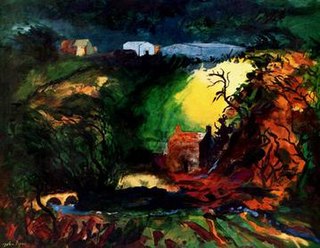
John Egerton Christmas Piper CH was an English painter, printmaker and designer of stained-glass windows and both opera and theatre sets. His work often focused on the British landscape, especially churches and monuments, and included tapestry designs, book jackets, screen prints, photography, fabrics and ceramics. He was educated at Epsom College and trained at the Richmond School of Art followed by the Royal College of Art in London. He turned from abstraction early in his career, concentrating on a more naturalistic but distinctive approach, but often worked in several different styles throughout his career.
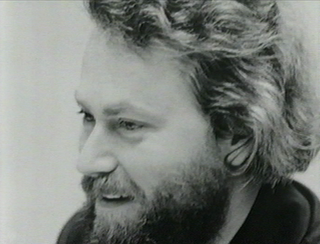
Donald Clarence Judd was an American artist associated with minimalism. In his work, Judd sought autonomy and clarity for the constructed object and the space created by it, ultimately achieving a rigorously democratic presentation without compositional hierarchy. He is generally considered the leading international exponent of "minimalism", and its most important theoretician through such writings as "Specific Objects" (1964). Judd voiced his unorthodox perception of minimalism in Arts Yearbook 8, where he says, "The new three dimensional work doesn't constitute a movement, school, or style. The common aspects are too general and too little common to define a movement. The differences are greater than the similarities."
Allen Jones is a British pop artist best known for his paintings, sculptures, and lithography. He was awarded the Prix des Jeunes Artistes at the 1963 Paris Biennale. He is a Senior Academician at the Royal Academy of Arts. In 2017 he returned to his home town to receive the award Honorary Doctor of Arts from Southampton Solent University
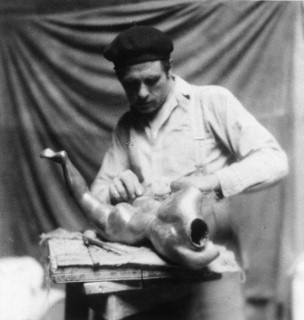
George Claude Leon Underwood was a British artist, although primarily known as a sculptor, printmaker and painter, he was also an influential teacher and promotor of African art. His travels in Mexico and West Africa had a substantial influence on his art, particularly on the representation of the human figure in his sculptures and paintings. Underwood is best known for his sculptures cast in bronze, carvings in marble, stone and wood and his drawings. His lifetime's work includes a wide range of media and activities, with an expressive and technical mastery. Underwood did not hold modernism and abstraction in art in high regard and this led to critics often ignoring his work until the 1960s when he came to be viewed as an important figure in the development of modern sculpture in Britain.

Ceri Giraldus Richards was a Welsh painter, print-maker and maker of reliefs.
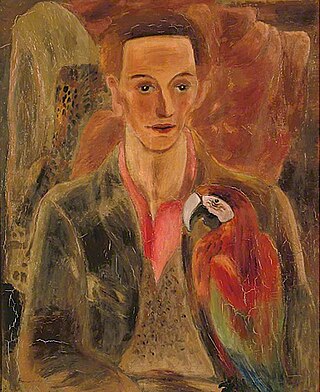
Sir Cedric Lockwood Morris, 9th Baronet was a British artist, art teacher and plantsman. He was born in Swansea in South Wales, but worked mainly in East Anglia. As an artist he is best known for his portraits, flower paintings and landscapes.

Shirazeh Houshiary is an Iranian-born English sculptor, installation artist, and painter. She lives and works in London.
The Artist Placement Group (APG) was conceived by Barbara Steveni in London in 1965, and established in 1966 as an artist-run organisation seeking to refocus art outside the gallery, predominantly through attaching an artist in a business or governmental context for a period of time. Then the participating artists would try to create and organize exhibitions of work related to those new experiences.

Dhruva Mistry is an Indian sculptor.

Maman (1999) is a bronze, stainless steel, and marble sculpture in several locations by the artist Louise Bourgeois. The sculpture, which depicts a spider, is among the world's largest, measuring over 30 ft high and over 33 ft wide (927 x 891 x 1024 cm). It includes a sac containing 32 marble eggs and its abdomen and thorax are made of rubbed bronze.
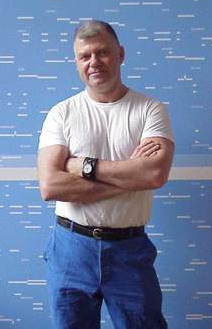
Keith Milow is a British artist. He grew up in Baldock, Hertfordshire, and lived in New York City (1980–2002) and Amsterdam (2002–2014), now lives in London. He is an abstract sculptor, painter and printmaker. His work has been characterised as architectural, monumental, procedural, enigmatic and poetical.
Margel Ina Harris Hinder was an Australian-American modernist sculptor, noted for her kinetic and public sculptural works. Her sculptures are found outside the Australian Reserve Bank building in Martin Place, Sydney, in a memorial in Newcastle, New South Wales, and in Canberra, ACT. Her work is held in several Australian public collections.
Kim Lim (1936–1997) was a Singaporean-British sculptor and printmaker of Chinese descent. She is most recognized for her abstract wooden and stone-carved sculptures that explore the relationship between art and nature, and works on paper that developed alongside her sculptural practice. Lim's attention to the minute details of curve, line and surface made her an exponent of minimalism.
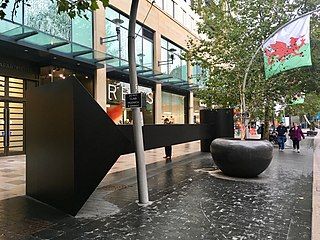
Untitled is a 1972 sculpture by Garth Evans.

Brian Wall is a British-born American sculptor now living in California. His work consists mainly of abstract welded steel constructions, and his career stretches over six decades. He has had numerous solo shows, and his sculptures reside in many private and museum collections. He was a faculty member at the Central School of Art in London, and a professor of art at the University of California, Berkeley.

Three Obliques (Walk In) is a 1968 sculpture by Barbara Hepworth. Three casts exist; two are in private collections and a third is displayed outside the Cardiff University School of Music in Cardiff, Wales. It is cast in bronze on a monumental scale.
Nicholas Evans was a self-taught Welsh artist from Aberdare. He signed his paintings Nick Evans and was sometimes known by that name. His work was influenced by his spiritual beliefs as a Pentecostalist.